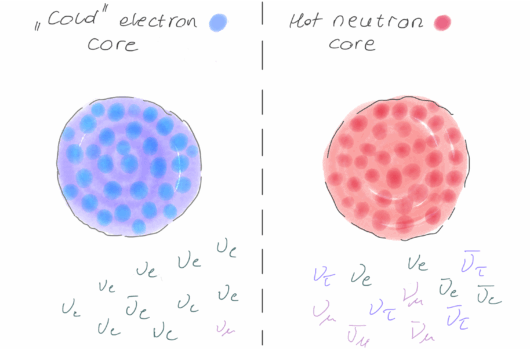r-process Nucleosynthesis and Kilonovae from Hypermassive Neutron Star Remnants
r-process Nucleosynthesis and Kilonovae from Hypermassive Neutron Star Remnants
View
Abstract
We investigate ![]() -process nucleosynthesis and kilonova emission resulting from binary neutron star (BNS) mergers based on a three-dimensional (3D) general-relativistic magnetohydrodynamic (GRMHD) simulation of a hypermassive neutron star (HMNS) remnant. The simulation includes a microphysical finite-temperature equation of state (EOS) and neutrino emission and absorption effects via a leakage scheme. We track the thermodynamic properties of the ejecta using Lagrangian tracer particles and determine its composition using the nuclear reaction network
-process nucleosynthesis and kilonova emission resulting from binary neutron star (BNS) mergers based on a three-dimensional (3D) general-relativistic magnetohydrodynamic (GRMHD) simulation of a hypermassive neutron star (HMNS) remnant. The simulation includes a microphysical finite-temperature equation of state (EOS) and neutrino emission and absorption effects via a leakage scheme. We track the thermodynamic properties of the ejecta using Lagrangian tracer particles and determine its composition using the nuclear reaction network ![]() . We investigate the impact of neutrinos on the nucleosynthetic yields by varying the neutrino luminosities during post-processing. The ejecta show a broad distribution with respect to their electron fraction
. We investigate the impact of neutrinos on the nucleosynthetic yields by varying the neutrino luminosities during post-processing. The ejecta show a broad distribution with respect to their electron fraction ![]() , peaking between
, peaking between ![]() 0.25-0.4 depending on the neutrino luminosity employed. We find that the resulting
0.25-0.4 depending on the neutrino luminosity employed. We find that the resulting ![]() -process abundance patterns differ from solar, with no significant production of material beyond the second
-process abundance patterns differ from solar, with no significant production of material beyond the second ![]() -process peak when using luminosities recorded by the tracer particles. We also map the HMNS outflows to the radiation hydrodynamics code
-process peak when using luminosities recorded by the tracer particles. We also map the HMNS outflows to the radiation hydrodynamics code ![]() and predict the evolution of the bolometric luminosity as well as broadband light curves of the kilonova. The bolometric light curve peaks on the timescale of a day and the brightest emission is seen in the infrared bands. This is the first direct calculation of the
and predict the evolution of the bolometric luminosity as well as broadband light curves of the kilonova. The bolometric light curve peaks on the timescale of a day and the brightest emission is seen in the infrared bands. This is the first direct calculation of the ![]() -process yields and kilonova signal expected from HMNS winds based on 3D GRMHD simulations. For longer-lived remnants, these winds may be the dominant ejecta component producing the kilonova emission.
-process yields and kilonova signal expected from HMNS winds based on 3D GRMHD simulations. For longer-lived remnants, these winds may be the dominant ejecta component producing the kilonova emission.





